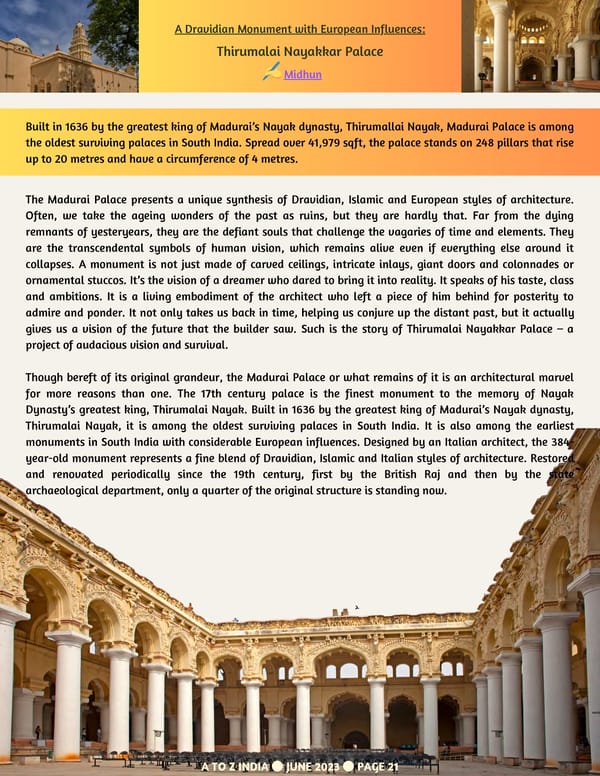A Dravidian Monument with European Influences: Thirumalai Nayakkar Palace Midhun Built in 1636 by the greatest king of Madurai’s Nayak dynasty, Thirumallai Nayak, Madurai Palace is among the oldest surviving palaces in South India. Spread over 41,979 sqft, the palace stands on 248 pillars that rise up to 20 metres and have a circumference of 4 metres. The Madurai Palace presents a unique synthesis of Dravidian, Islamic and European styles of architecture. Often, we take the ageing wonders of the past as ruins, but they are hardly that. Far from the dying remnants of yesteryears, they are the defiant souls that challenge the vagaries of time and elements. They are the transcendental symbols of human vision, which remains alive even if everything else around it collapses. A monument is not just made of carved ceilings, intricate inlays, giant doors and colonnades or ornamental stuccos. It’s the vision of a dreamer who dared to bring it into reality. It speaks of his taste, class and ambitions. It is a living embodiment of the architect who left a piece of him behind for posterity to admire and ponder. It not only takes us back in time, helping us conjure up the distant past, but it actually gives us a vision of the future that the builder saw. Such is the story of Thirumalai Nayakkar Palace – a project of audacious vision and survival. Though bereft of its original grandeur, the Madurai Palace or what remains of it is an architectural marvel for more reasons than one. The 17th century palace is the finest monument to the memory of Nayak Dynasty’s greatest king, Thirumalai Nayak. Built in 1636 by the greatest king of Madurai’s Nayak dynasty, Thirumalai Nayak, it is among the oldest surviving palaces in South India. It is also among the earliest monuments in South India with considerable European influences. Designed by an Italian architect, the 384- year-old monument represents a fine blend of Dravidian, Islamic and Italian styles of architecture. Restored and renovated periodically since the 19th century, first by the British Raj and then by the state archaeological department, only a quarter of the original structure is standing now. A TO Z INDIA ● JUNE 2023 ● PAGE 21
 A TO Z INDIA - JUNE 2023 Page 20 Page 22
A TO Z INDIA - JUNE 2023 Page 20 Page 22